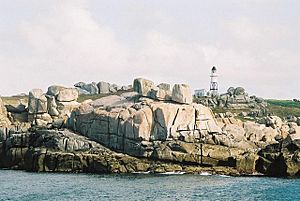Peninnis Head facts for kids
| Site of Special Scientific Interest | |

Penninnis Head with lighthouse
|
|
| Area of Search | Cornwall |
|---|---|
| Coordinates | 49°54′19″N 6°18′10″W / 49.9053°N 6.3029°W |
| Interest | Biological and Geological |
| Area | 16.1 hectares (0.161 km2; 0.0622 sq mi) |
| Notification | 1971 |
Peninnis Head is the most southern point of St Mary's island, which is part of the Isles of Scilly. This special area is known for its amazing natural beauty. It is part of a protected area called an Area of Outstanding Natural Beauty and also a Heritage Coast.
Peninnis Head is also a Site of Special Scientific Interest (SSSI). This means it's a place with important plants, animals, or rocks that are protected. It was first named an SSSI in 1971 because of its interesting wildlife and unique rock formations. At the very tip of the headland, you'll find the Peninnis Lighthouse. This lighthouse was built in 1911 by Trinity House. It replaced an older lighthouse on St Agnes island that had been there since the 1600s.
There's a rock called the Gilstone near Peninnis Head. Don't mix it up with another rock of the same name in the Western Rocks!
Contents
Peninnis Head's Rocks and Land
The rocks at Peninnis Head are made of a type of granite. This granite has been shaped by the weather over many years. It has formed cool natural sculptures and piles of rocks. Some of these even have names, like the "Pulpit Rock."
In some spots, there are layers of soil that have built up. These thin soils are perfect for a type of plant community called "waved maritime heath." Peninnis Head is a special place for studying geology. This is because it doesn't show many signs of the Ice Age. This helps scientists compare it to other places, like Tresco island, where glaciers did touch the granite.
Plants and Animals of Peninnis Head
Peninnis Head is home to many interesting plants. The main plants you'll see in the "waved maritime heath" are western gorse, heather, and bell heather. In areas with deeper soil, you might find bracken, European gorse, bramble, and honeysuckle. These plants are growing more, which changes the natural heath. Because of this, the area is being carefully managed to help the original plants recover.
You can also find some unusual plants in the grassy areas near the sea. These include spring squill and thyme. Other common plants here are red fescue, Yorkshire fog, thrift, sea beet, common sorrel, common scurvygrass, and buck's–horn plantain. Two rare plants found here are early meadowgrass and western clover.
Lichens
Peninnis Head is very windy and gets a lot of sea spray. This makes it a great place for many lichens to grow, especially at the very tip. Lichens are like a mix of fungi and algae living together. Some lichens you might see here include the common sea ivory. There are also some rarer ones like Roccella fuciformis, R. phycopsis, and golden hair-lichen. A very special type found here is the BAP species called ciliate strap-lichen.
History of Peninnis Head
During the Second World War (1939–1945), a special station was built on Peninnis Head. It was called a Radio Direction Finding Station (RDF). This station helped find enemy aircraft and ships.
The first time the islands were attacked by an enemy was on August 21, 1940. Aircraft bombed this RDF station. It was attacked several more times and was eventually destroyed about a year after the first attack.
The Peninnis Lighthouse was built in 1911. It took over from an older lighthouse on St Agnes island that had been working since 1680. The light from Peninnis Lighthouse helps ships safely enter Hugh Town harbour. When it was first built, it used gas (acetylene) for its light. In 1992, it was updated to use electricity.


